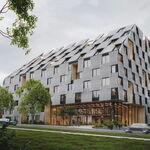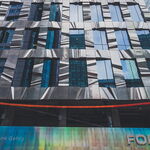robmausser
Senior Member
I bike so that I can eat a whole bag of chips and still don't have to worry about gaining any weight.
This is known as a "guyet"
I bike so that I can eat a whole bag of chips and still don't have to worry about gaining any weight.
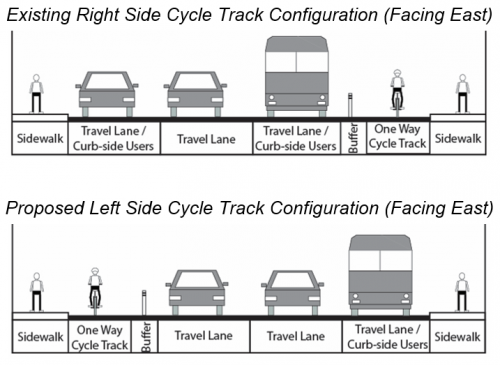

I agree that it would have been nice if they thought of this sooner. However, looking at it I doubt they would have to tear any of it up, just extend it a bit further north to allow southbound turners to have a bit of queueing space. The northbound cyclists from the other Adelaide would just have to bike a bit further. The only other change may be to extend the curb in the intersection to close the opening cyclists currently use as an exit.I wonder what that would mean for the Bathurst/Adelaide section, which just finished its reconfiguration to support the bike lane connection:
View attachment 146229
This design isn't going to accommodate southbound left-turning cyclists on Bathurst, who will either have to stop right in the bike lane or pull forward just to double back to the other side of Adelaide. Is the city going to tear this up and reconstruct it to move the bike waiting area north? I am annoyed that nobody thought about this a year ago!
And this is my immediate concern.The number of traffic lanes, bike lane width, and use of flexi-posts with planters, is expected to remain about the same, mirrored on the left side.
They do it with concrete barrier separated lanes!While this would be the first left side bike lane in Toronto, left side bike lanes can be found in many cities including Hamilton, Boston, New York, Chicago, and Philadelphia.
Here we go again. That promise was made for the year following their first institution. It helps, but it's far from being safe or acceptable. Richmond and Adelaide bike lanes ferry more persons in an out of downtown TO in rush hour than persons entering/exiting the core on the DVP. Let's build highway infrastructure out of cardboard and plasticine. We'll decide later whether to use concrete or not.If the Richmond-Adelaide Cycle Tracks are approved as a permanent cycling facility, modifications would be made to the design in the future. Potential modifications could include providing a greater degree of separation between cyclists and motor vehicles, pavement marking modifications, and traffic signal timing modifications.
Bike lane design allows for hearse parking
https://www.thestar.com/news/gta/2017/12/07/bike-lane-design-allows-for-hearse-parking.htmlBy SARAH-JOYCE BATTERSBYMetro News
Thu., Dec. 7, 2017
A new turning lane and traffic light dedicated to bikes shows cycling is alive and well in Toronto. But a lack of curb to keep cars out has some critics questioning the design.
The driving force? Hearses.
/https://www.thestar.com/content/dam/thestar/news/gta/2017/12/07/bike-lane-design-allows-for-hearse-parking/hearse_area.jpg)
This green area outside St. Mary's Church at Bathurst and Adelaide Sts. is supposed to offer both hearse parking and protection for cyclists. (EDUARDO LIMA / METRO NEWS)
The $550,000 project at Bathurst and Adelaide Sts. sits directly in front of St. Mary’s Church, which has hosted funerals for more than a century.
Consultations with the church and the cycling community led to the concession, in part to allow hearses to park out front.
“It’s a pretty understandable consideration that we’re making, given that it’s a church and it holds funerals,” Coun. Mike Layton told Metro, adding the compromise upholds the site’s existing use while providing “significant” protection for bikes.
The open design also accommodates the large volume of bikes that can collect at the intersection, he said. (More than 500 riders clock through the spot during morning rush hour.)
Though the church has other entrances and a parking lot, Layton said other buildings and additions constructed over the years don’t allow for a direct route to the sanctuary.
“It really wasn’t feasible or realistic to think that people would walk out the front door with a casket and walk it around the building,” he said.
Cyclist Hanno Rein told Metro in an email that the decision pits the safety of some over the convenience of others and shows a lack of commitment to the city’s Vision Zero road safety goals. It’s a conflict he sees repeated in other areas, such as reducing speed limits, narrowing lanes and installing more pedestrian crossings.
“If the politicians of this city continue to run on platforms that focus on speeding up cars that move through our city, we’ll need a lot more hearses in the future,” he said.
Parked cars, including limos and hearses, have been spotted in the lane since it opened, prompting calls on Twitter to review the design.
“Classic Toronto: almost good, but not quite,” wrote @robmclarty.
“This is too common and why infrastructure can’t depend on the goodwill of drivers or 9-5 enforcement,” wrote @awkwartunity.
Hearses have been spotted in bike lanes elsewhere in the city. Just last week Twitter user @matthewdvm sent out a photo of such a scene in the Sherbourne bike lanes.
Toronto police generally use their discretion when it comes to ticketing funeral vehicles, according to a traffic services officer.
St. Mary’s declined to comment when reached by phone, but the church website published a brief statement ahead of the lane’s opening that read, in part: “Our hope is that cyclists have a safer commute by utilizing the new lanes and respecting the parish property.”
Calling the change a “major improvement,” Layton said the compromise helps preserve the city’s heritage.
“(The church) has been there longer than all of us,” he said. “It will be there longer than all of us.”
What are thoughts on making one way streets exempt for bicycles? In cabbagetown where I live bikes are always going the wrong way on Sackville, Sumach, Amelia, Salisbury and Metcaffe. Might as well make it legal so that auto users are less inclined to roll down their windows to tell off cyclists, which I see often.
We do that already in places in Toronto. Just make it so in more places. Having a dozen bikes coming up a street should slow traffic down (hopefully safely).Only thing City can do is to mark the one-ways bike contra-direction allowable. And the more I think about it, that's the only safe...*safer* way to do it. It's dangerous enough already on some contra marked one-ways.
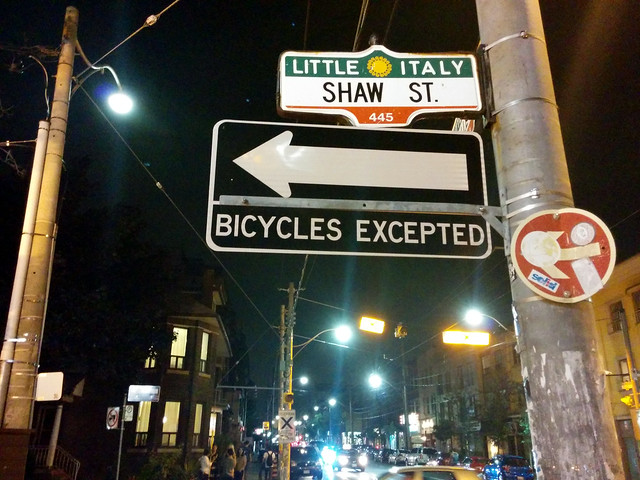
We do that already in places in Toronto. Just make it so in more places. Having a dozen bikes coming up a street should slow traffic down (hopefully safely).
Googled: Toronto Do Not Enter or One Way Sign, Bikes Exempt

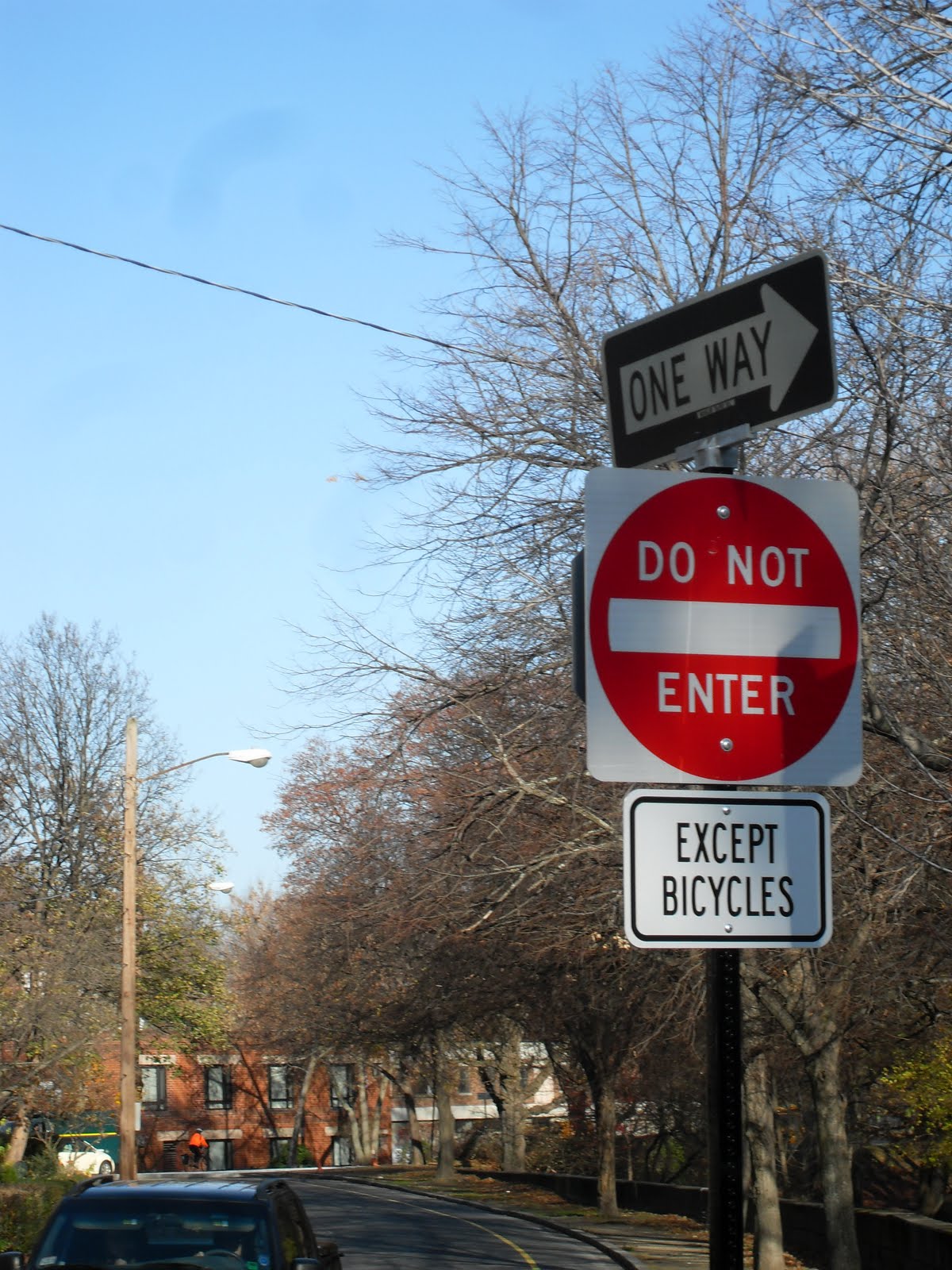
It would certainly work in Cabbagetown, even where the one way streets have parking on one side, as the remaining road is still wide enough for two cars. So, add the counter-direction bike lane, and cars will still be fine, whilst bikes are given their due space.However the street in each of these examples have a contra-flow bike lane, hence cyclists are allowed to go in the opposite direction. I think they work great and I would like to see them implemented on all one-way streets.
http://dandyhorsemagazine.com/blog/...-lane-connects-you-through-kensington-market/[...]
Unfortunately, not everything about this new lane is sunshine and rainbows. The section north of Dundas is a hotbed for cars parked in the bike lane - especially U-haul’s belonging to the rental agency on the corner. Despite numerous tickets on the windshield, there seems to be no sign of the trucks moving anytime soon. Where is TPS parking pal when you need him? Despite these parking infractions, most cars were courteous and slowed to allow me to continue my route north in the oncoming car lane.
Continuing north, the contraflow lane follows Bellevue Avenue up to College Street, where there is no stop light, and none likely to come. This may provide for a tough left turn for many riders, crossing four lanes of car traffic in order to safely reach the westbound bike lane. Luckily, there is a stop light one street directly to the west (and east), which will allow for a more comfortable crossing at busy times of the day.
Local resident Lisa Logan said she doesn't think the sharrows are all that bad. "Who knew the city cared?? Well, they do, I guess. And literally a day into it, I saw people riding. Build it and they will ride! Those types of markings make a big difference, as cyclists will often ride routes easy for them regardless of a one way st and this certainly makes it safer," she said, "And the markings encourage car drivers to slow down in their confusion of the new infrastructure. Why wouldn't one typically slow down on a street busy with pedestrians, cyclists, school kids, buses, a fire station, etc.? This new lane adds to the complete street and it works. Looking forward to more 'surprises' that encourage and support complete streets."
Every-day cyclist and Cycle Toronto volunteer, Robert Zaichkowski said, "I feel it's a great way to connect College Street to the Richmond-Adelaide cycle tracks via Kensington Market with good use of wayfinding sharrows where the gaps are. However, I do feel there needs to be improved wayfinding for those getting to Kensington Market from the Richmond-Adelaide cycle tracks."
Still, I believe the Denison/Bellevue contraflow lane marks an important north-south connection (one that took many years to become a reality) that takes riders through one of Toronto’s most vibrant neighbourhoods, and continues to build upon the City’s Cycling Network Plan. After the success of the Bloor Street bike lanes at council this week, things are looking up for cycling in the city.
